Red spots on the skin are commonly caused by allergies, viral infections or fungal infections. They can also be a sign of a more chronic issue, like lupus, rosacea or psoriasis.
Red or pink discoloration on the skin can present with other symptoms like itching, fever, warmer skin and flaking skin. Some red spots on the skin may even develop into fluid-filled blisters. A very sudden red skin rash from an unknown cause should be assessed by your doctor immediately.
In addition to inspecting the red spots on the skin, the doctor will evaluate any other symptoms you may be having to reach a diagnosis. Depending on the cause, treatment may include some ointments, painkillers, anti-inflammatories or antibiotics.
Symptom quiz
Enter your symptoms below to determine what about be causing red spots on your skin:
Please note that this quiz is only a guidance tool and does not replace an assessment or diagnosis by your doctor.
What causes red spots on the skin?
The main causes for red spots on the skin are:
1. Allergies

What it looks like: Medium-sized patches that are very itchy and may be filled with fluid. They generally appear after contact with plants or fur, or after ingesting some types of medications. Allergy rashes may also be caused by insect bites or food poisoning.
Treatment: Symptoms can be relieved with specific medication to treat allergies, such as: loratadine, corticosteroids (e.g. prednisone), or topical creams (e.g. promethazine). They should be taken as prescribed.
2. Fungal infections

What it looks like: Patches can be large in size and normally affect a specific area of the body. There may also be blisters and the skin in the affected area may be appear to be scaling.
Treatment: It usually includes the use of antifungal medicine and sometimes even antibiotics. Read more about ways to treat a yeast infection naturally.
3. Heat rash
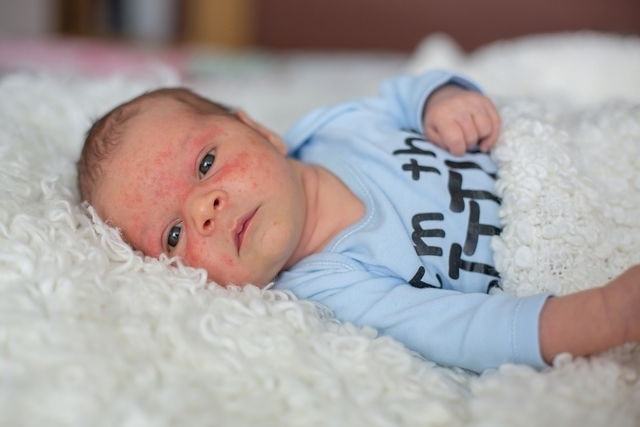
What it looks like: Small red patches that normally have little red dots. They cause a burning sensation and appear mainly on the face, neck, back, chest and thighs. Learn more about the symptoms of a heat rash and what can cause it.
Treatment: There is no specific treatment for heat rash, but that you should keep the affected area cool and apply cold compresses.
4. Chicken pox
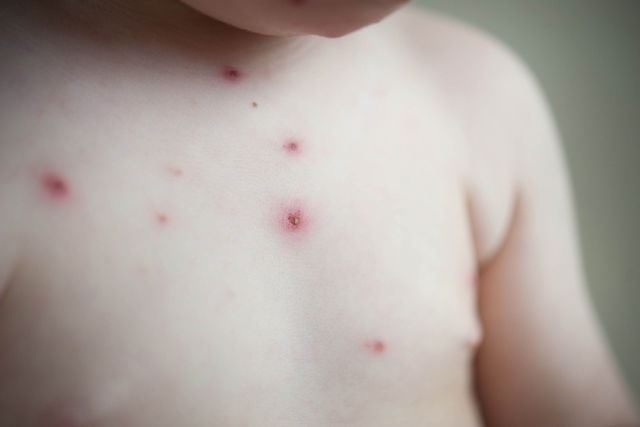
What it looks like: Small blisters and patches that appear all over the body and cause a lot of itchiness.
Treatment: Plenty of rest, analgesic medication (e.g. acetaminophen) to treat discomfort, and betadine on the blisters to prevent infection. Any medications should be used as prescribed, especially when administered to children.
5. Measles
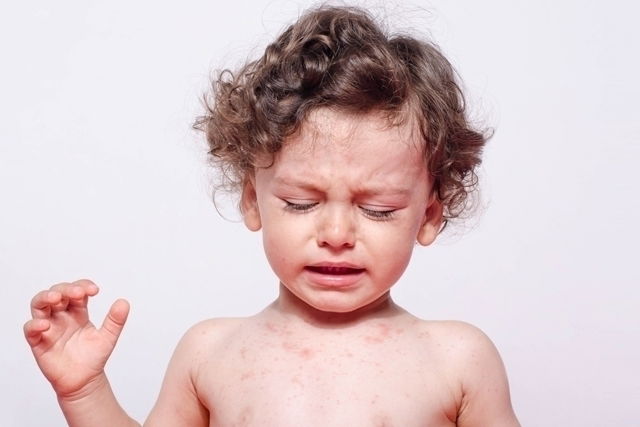
What it looks like: Small spots that are not itchy or painful but that can spread all over the body. Learn more about the symptoms of measles and complete our online symptom checker if you suspect you may have it.
Treatment: Plenty of rest, hydration and acetaminophen as prescribed. Read more about the measles treatment your doctor may advise.
6. Zika virus

What it looks like: Little red bumps that are slightly raised and cause itchiness. They usually appear within 3 days of a mosquito bite. The Zika rash usually appears on the face and then spreads to the rest of the body in just a few hours, and lasts for about five days.
Treatment: Rest, hydration and medication for symptom relief as prescribed by a doctor (e.g. acetaminophen).
7. Eczema
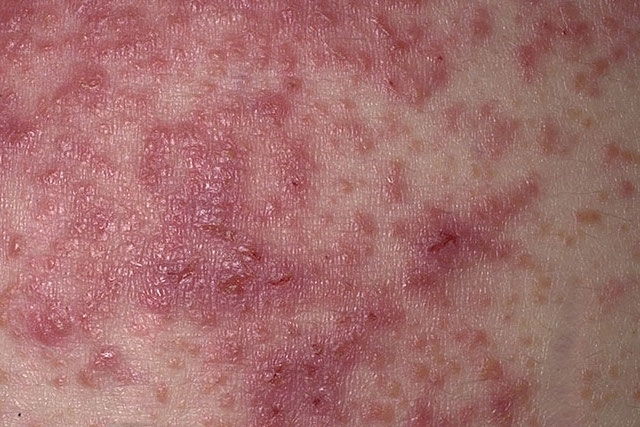
What it looks like: The rash causes a lot of itchiness and can get swollen. This type of rash is very common in children and in health professionals who wash their hands frequently with antibacterial soap. Learn more about symptoms associated with eczema and what can cause it.
Also recommended: Baby Eczema: Symptoms, Treatment & Prevention tuasaude.com/en/baby-eczemaTreatment: Medication like loratadine, ointments and corticosteroid creams as prescribed by your doctor. Read more about the eczema creams your doctor may prescribe.
8. Scabies
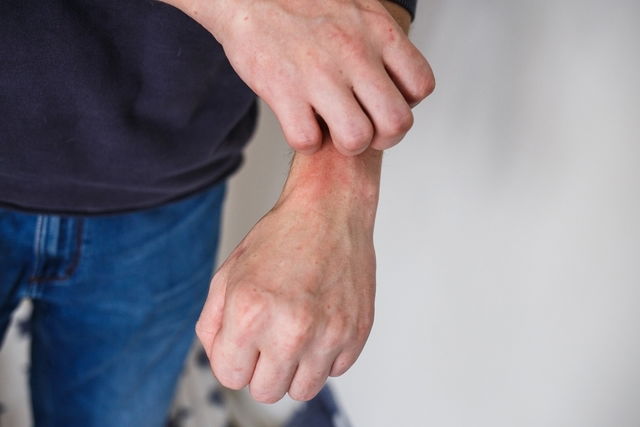
What it looks like: A rash that usually appears on the hands and the armpits and is extremely itchy, especially at night. Learn more about how scabies is transmitted and the other symptoms associated with it.
Treatment: Creams and ointments prescribed by a doctor, which will vary depending on the intensity of symptoms. Common medications used to treat scabies include ivermectin, crotamiton and permethrin.
9. Rubella (German measles)
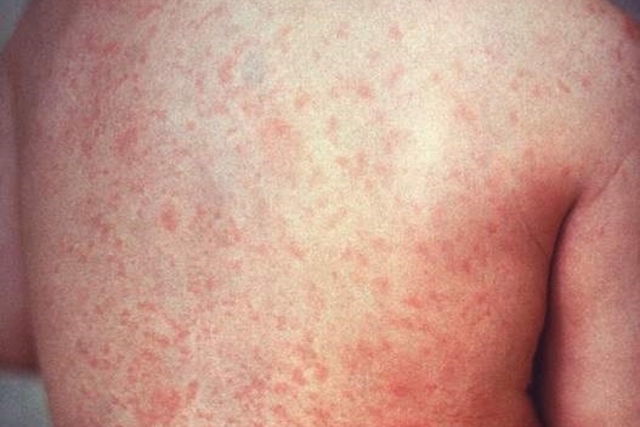
What it looks like: Small, slightly raised bumps that cause itchiness. They normally start on the face and behind the ears, but they quickly spread through the body and last for around three days. Learn more about rubella symptoms and how they may present.
Treatment: Treatment should be followed as instructed by a doctor, who will monitor you until the illness resolves.
10. Atopic dermatitis
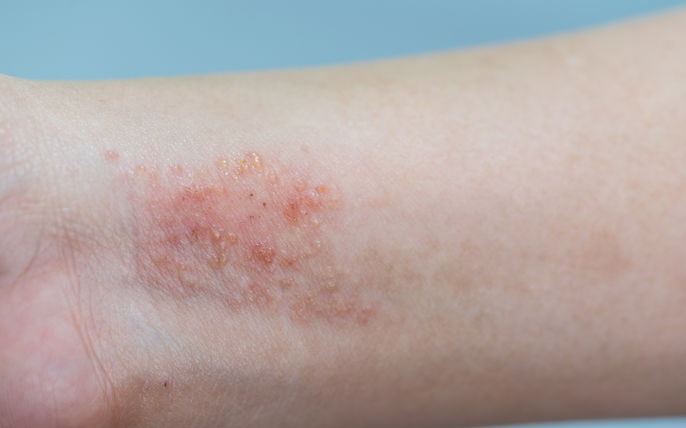
What it looks like: Rashes that are very itchy and may be scaly.
Treatment: Prescription creams and ointments with corticosteroids, as prescribed by a doctor. A dermatitis diet may also be beneficial to some patients.
11. Psoriasis
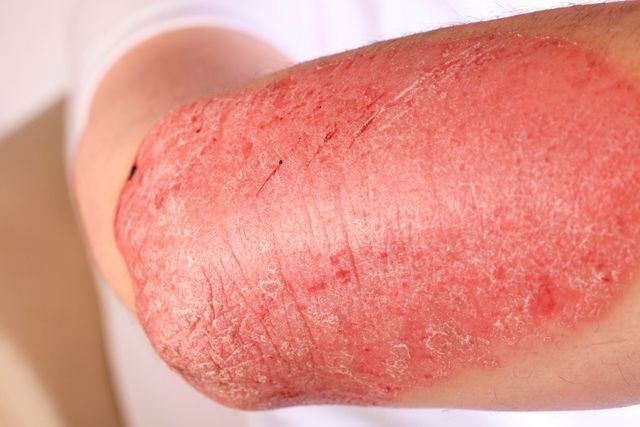
What it looks like: Itchy blotches that may have a white spot in the middle with dry, red, flaky edges. They are more frequent in people under 30 or over 50. These blotches are not contagious, but they are linked to genetic factors. See what causes psoriasis and what other symptoms may emerge.
Treatment: Application of creams and topical anti-inflammatories as prescribed by a dermatologist. Increasing sun exposure may also help to resolve skin changes. Diet plays an important role in the treatment of psoriasis. and you should aim to avoid fatty and processed food, and increase your intake of foods high in omega-3 and beta carotene.
Also recommended: 9 Home Remedies for Psoriasis (& Other Natural Treatments) tuasaude.com/en/home-remedies-for-psoriasis12. Lupus

What it looks like: Red patches that are flat or raised and appear anywhere on the body. They are more frequent in women. Learn about what causes lupus and other symptoms associated with this condition.
Treatment: Corticosteroids and immunosuppressants as prescribed by a doctor. Learn more about how lupus symptoms are managed.
13. Rosacea
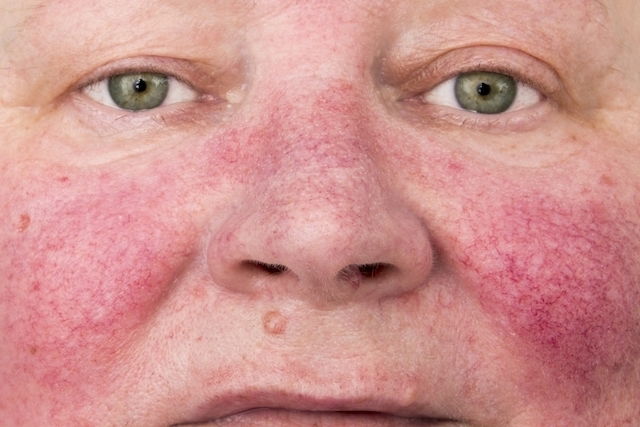
What it looks like: Patches with little vessels that generally appear on the cheeks, forehead and nose. Besides the presence of a rash, the skin is also more sensitive, hot and swollen.
Treatment: Use of neutral soaps and moisturizers can help to control the redness. In some cases, the dermatologist may also prescribe antibiotics or anti-inflammatory medication.
14. Skin cancer
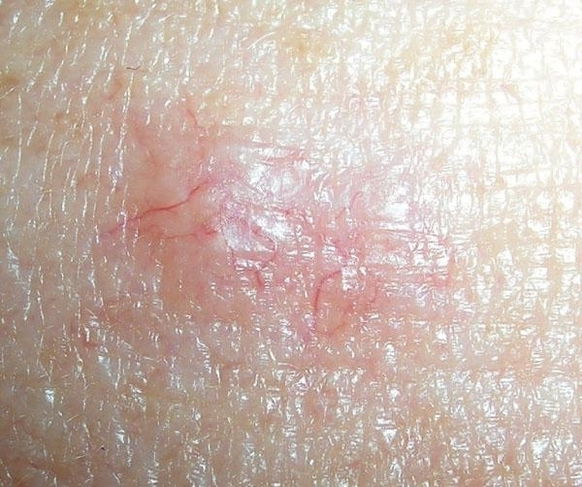
What it looks like: Small spots or wounds that have an irregular shape and increase in size with time and/or bleed.
Treatment: Surgery, radiation therapy or chemotherapy according to the characteristics of the spots.
15. Poor circulation
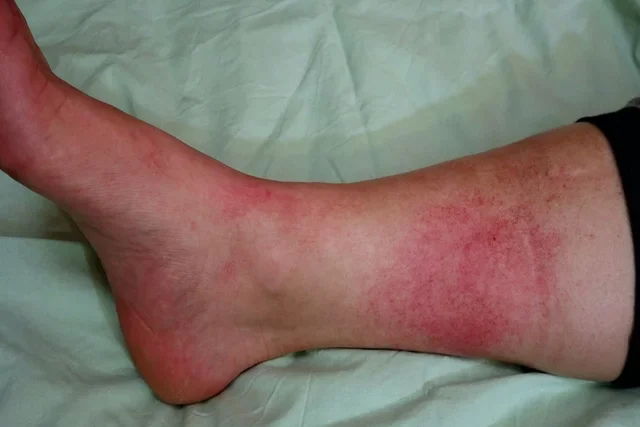
What it looks like: Red spots, which can also have a yellowish or brown color, mainly on the legs, in the ankle area. They are usually accompanied by other symptoms such as itchy skin, the presence of spider veins or varicose veins, swollen feet or ankles, a tingling sensation or pain. In more severe cases, sores can start to form on the skin.
Red spots from poor circulation can appear from standing, sitting or lying down for too long, or due to health conditions such as varicose veins, venous insufficiency or deep vein thrombosis, for example. These are related to blood accumulating in the legs due to inadequate blood return to the heart.
Also recommended: Poor Circulation in Legs: Symptoms, Causes & Treatment tuasaude.com/en/poor-circulation-in-legsTreatment: Treatment should be monitored by a doctor, who may recommend the use of compression stockings to promote optimal blood circulation, Ointments may be applied to the site of inflammation, and oral antibiotics may be needed for infected wounds. Patients are advised to avoid standing or sitting for long periods of time and to elevate the legs when possible to avoid blood accumulation.
Check-out how to improve circulation using natural remedies.
16. Erysipelas

What it looks like: Red patches with raised, irregular edges. Fever, chills and malaise usually appear around 48 hours before the patches appear, which may be accompanied by other symptoms such as a burning sensation in the affected area, itching, pain or increased sensitivity. In the serious cases, blisters may appear on the skin and the skin in the affected area may become darker.
Erysipelas is an infection of the superficial layer of the skin, caused by Streptcoccus pyogenes bacteria. This bacteria can penetrate the skin through skin lesions, like wounds or insect bites. This infection can also occur due to chronic venous ulcer or improper managements of the nails, chilblains and athlete's foot. Erysipelas usually affects the legs or feet, and is most common in people who suffer from obesity, poorly controlled diabetes, eczema or leg ulcers.
Treatment: Erysipelas is treated with antibiotics prescribed by a dermatologist.
17. Lichen planus
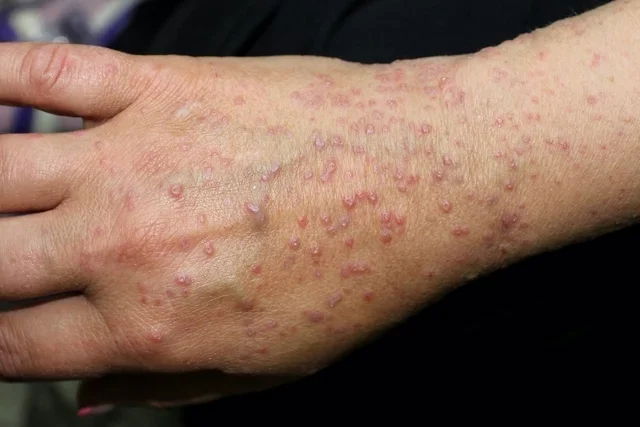
What it looks like: Patches that appear in the form of small red or purplish plaques on the skin. These usually itch and have a shiny surface covered in thin white stripes. They most commonly appear on the wrist, ankle or lower back.
Lichen planus is an inflammation of the skin and its causes are not entirely known. However, some factors can increase the risk of the patches appearing, such as hepatitis C, stress or the use of antimalarial drugs, non-steroidal anti-inflammatory drugs or thiazide diuretics.
Treatment: you can use antihistamines or corticosteroids in the form of ointments or tablets, as prescribed by your dermatologist.
18. Cutaneous scleroderma
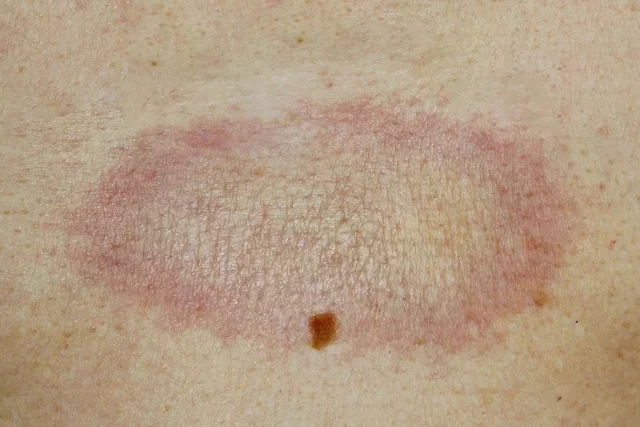
What it looks like: One or more red spots, which can become hardened and white in the center, with reddish edges. Over time, the spots can become darker.
Scleroderma is a chronic autoimmune disease in which there is an overproduction of collagen, leading to the appearance of symptoms on the skin, but it can also affect some internal organs, such as the lungs and heart, or the joints, muscles and blood vessels.
Treatment: Cutaneous scleroderma can be treated with the use of corticoids in the form of ointments or tablets, prescribed by a dermatologist.
19. Dengue
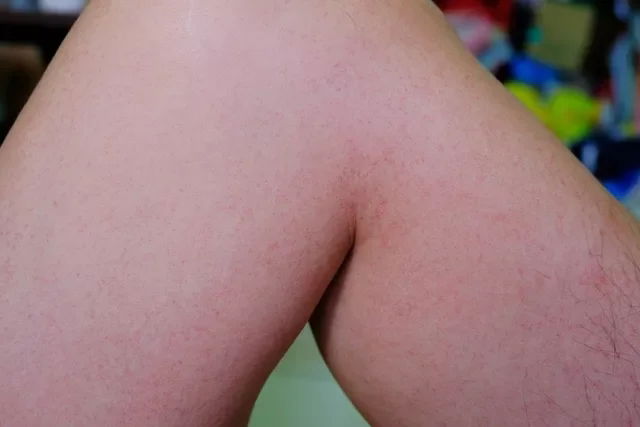
Dengue is an infection caused by Flavivirus viruses of serotypes DENV-1, 2, 3 or 4. It is transmitted through the bite of Aedes aegypti mosquitoes, and causes symptoms like fever and red spots on the skin, mainly on the legs or chest.
Other symptoms of dengue are headaches, muscle aches, pain behind the eyes and general malaise. Read more about dengue symptoms to monitor.
How to treat: Dengue treatment should be carried out as directed by a general practitioner or infectious disease specialist. The doctor may prescribe dengue medications like acetaminophen to relieve symptoms. It is also essential to rest and drink plenty of water.
Also recommended: What to Eat & Avoid for Dengue Treatment (w/ 3-Day Meal Plan) tuasaude.com/en/foods-that-can-speed-up-recovery-from-dengueIn more serious cases, or with hemorrhagic dengue, treatment involves hospitalization to receive IV fluids and medication and blood transfusions as needed. Learn more about dengue treatment that your doctor may consider.































